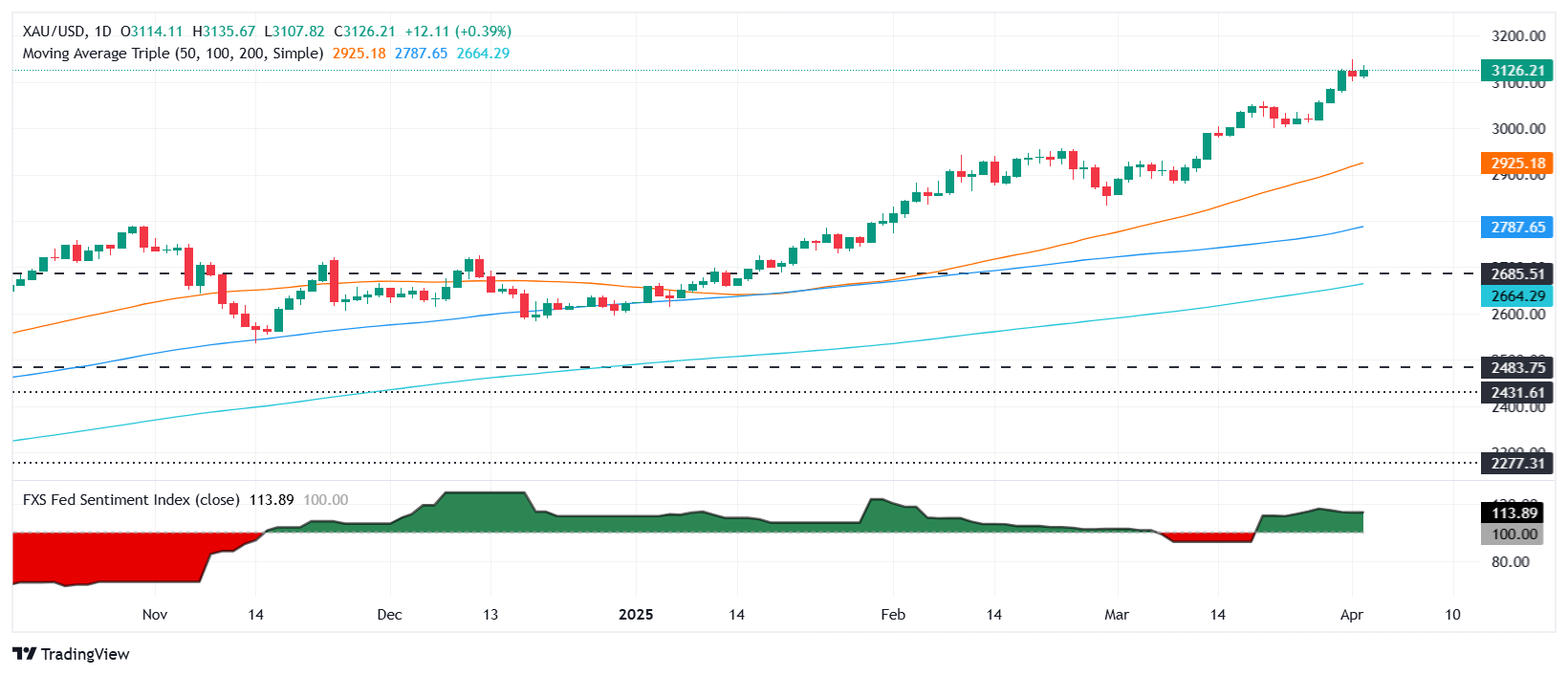- XAU/USD trades above $3,120 as markets brace for sweeping US trade measures; Dollar weakness offsets rising yields.
- Trump to unveil tariff plans; options include blanket 20% duties or country-by-country levies.
- Gold is up 23% since its post-election low; traders eye potential unwinding if tariffs prove less aggressive than feared.
Gold price extends its gains on Wednesday, remaining near all-time highs as market participants wait for US President Donald Trump’s tariff plans at around 20:00 GMT. XAU/USD trades at $3,122, gaining 0.28%.
US Liberation Day is finally here. Trump is expected to unveil reciprocal tariffs, which are aimed at reducing the US trade deficit with its partners. Last week, he announced a 25% duty on imported automobiles and the tariff suspension on Mexico and Canada is expected to end on April 3.
A day ago, media reports suggested that three options are under discussion: a blanket tariff of 20%, tiered tariffs, and targeted duties applied on a country-by-country basis.
Standard Chartered analyst Suki Cooper commented, “If the tariffs are not as extensive as feared, some positioning could be unwound in Gold, in which case the physical market floor will be key in setting the downside.”
Since US President Donald Trump won the election, Gold prices initially dipped before rallying and gaining over 23% from the November 14 low, when XAU/USD hit $2,536.
Bullion prices have extended their gains despite rising US yields. However, the broad weakness of the US Dollar (USD) kept Gold prices holding firm above the $3,100 mark.
US economic data has taken a backseat amid tariff jitters. ADP revealed that private companies hired more people than expected, while Factory Orders expanded above estimates but showed some signs of slowing down.
Ahead this week, traders are focusing on the Trump tariff announcement, the ISM Services PMI for March, Nonfarm Payroll figures, and Fed Chair Jerome Powell’s speech.
Daily digest market movers: Gold price edges up amid high US yields
- The US 10-year T-note yield rises three basis points to 4.19%. US real yields edge up three bps to 1.862%, according to US 10-year Treasury Inflation-Protected Securities (TIPS) yields.
- The ADP National Employment Report for March showed that businesses added 155K jobs, beating expectations of just over 105K and significantly higher than February’s 84K increase, signaling continued strength in private sector hiring.
- Meanwhile, Factory Orders rose 0.6% MoM in February, slightly above the 0.5% forecast, though slowing from January’s 1.8% surge.
- Looking ahead, Donald Trump is expected to announce reciprocal tariffs on US trading partners during an address in the White House Rose Garden, a move likely to stir market volatility and global trade tensions.
- The latest estimate from the Atlanta Fed’s GDP Now model indicates that the GDP for Q1 2025 is expected to contract by 3.7%, down from the 2.8% estimate on March 28.
- Money market futures pricing in more than 73 basis points of interest rate cuts by the Federal Reserve (Fed).
XAU/USD technical outlook: Gold price retreats from all-time highs near $3,150
The uptrend in Gold prices remains intact; however, buyers’ lack of commitment to push prices to record highs keeps the yellow metal trading sideways. The Relative Strength Index (RSI) is above the 70 level, indicating overbought territory. Traders should note that, due to the strength of the trend, the most extreme reading can reach 80. Therefore, further upside is anticipated.
If XAU/USD stays above $3,100, buyers maintain control. An extension of the rally would trigger a breach of the record high at $3,149, followed by the $3,200 mark. Conversely, a drop below $3,100 would expose the March 20 high, which has since become support at $3,057, followed by the $3,000 mark.

Gold FAQs
Gold has played a key role in human’s history as it has been widely used as a store of value and medium of exchange. Currently, apart from its shine and usage for jewelry, the precious metal is widely seen as a safe-haven asset, meaning that it is considered a good investment during turbulent times. Gold is also widely seen as a hedge against inflation and against depreciating currencies as it doesn’t rely on any specific issuer or government.
Central banks are the biggest Gold holders. In their aim to support their currencies in turbulent times, central banks tend to diversify their reserves and buy Gold to improve the perceived strength of the economy and the currency. High Gold reserves can be a source of trust for a country’s solvency. Central banks added 1,136 tonnes of Gold worth around $70 billion to their reserves in 2022, according to data from the World Gold Council. This is the highest yearly purchase since records began. Central banks from emerging economies such as China, India and Turkey are quickly increasing their Gold reserves.
Gold has an inverse correlation with the US Dollar and US Treasuries, which are both major reserve and safe-haven assets. When the Dollar depreciates, Gold tends to rise, enabling investors and central banks to diversify their assets in turbulent times. Gold is also inversely correlated with risk assets. A rally in the stock market tends to weaken Gold price, while sell-offs in riskier markets tend to favor the precious metal.
The price can move due to a wide range of factors. Geopolitical instability or fears of a deep recession can quickly make Gold price escalate due to its safe-haven status. As a yield-less asset, Gold tends to rise with lower interest rates, while higher cost of money usually weighs down on the yellow metal. Still, most moves depend on how the US Dollar (USD) behaves as the asset is priced in dollars (XAU/USD). A strong Dollar tends to keep the price of Gold controlled, whereas a weaker Dollar is likely to push Gold prices up.

























